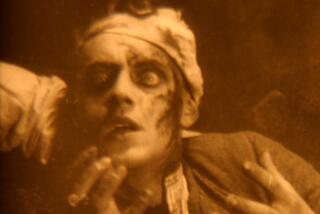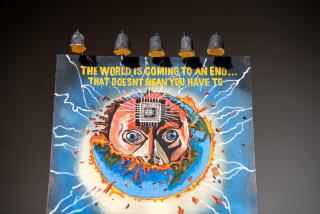Historyâs Bits and Pieces Make It All Seem So Real
Carpool advocates didnât mess around during World War II. They went right for the gut. âWhen You Ride Alone,â declared a 1943 government poster, âYou Ride With Hitler!â The illustration showed a businessman driving along in his convertible, nattily dressed in suit and tie, with the ghostly outline of Adolf Hitler sitting next to him in the passenger seat.
The poster, beautifully illustrated by graphic artist Weimer Pursell, was part of an exhibit that appeared in Washington, D.C., from May 1994 to February 1995. If you missed it, you can still catch it and much more, on one of the most captivating sites online.
Itâs sponsored by the National Archives and Records Administration, best known as the safe keeper of some of this countryâs most cherished documents, including the Constitution and Declaration of Independence. But it also has vast holdings of far more mundane but fascinating items.
Point your browser to https://www.nara.gov and click on âOnline Exhibit Hallâ to find a variety of presentations, including, âPowers of Persuasion--Poster Art From World War II.â
The exhibit is divided into two sections, with the carpooling poster grouped in with others that sought to ârock people out of their complacency with grim, unromantic visions of war.â In the same group is a 1942 poster by Lawrence B. Smith of three adorable children, looking frightened as they ponder the shadow of a giant swastika nearby. âDonât Let That Shadow Touch Them,â warns the poster. âBuy War Bonds.â
Even more graphic is a poster showing a dead soldier, his body slumped over a barbed wire fence. âYou Talk of Sacrifice,â it says. âHe Knew the Meaning of Sacrifice!â
More moderate are the posters in the other section, promoting positive, patriotic messages. âWe Can Do It!â declares one by J. Howard Miller that features the depiction of a woman rolling up her sleeves to get ready for factory work.
Elsewhere on the site is the âAmerican Originalsâ exhibit, showing rather mundane looking documents that were part of historic events.
Here you can view the entry in a security logbook, dated June 17, 1972, that notes police were called at 1:47 a.m. upon discovery of a break-in at an office complex known as Watergate. In this same section, you can see a letter on official White House stationery, dated Aug. 9, 1994, that simply reads, âI hereby resign the Office of President of the United States.â
There is also a Washington, D.C., police blotter entry from Aug. 14, 1865, that notes, âAt this hour the melancholy intelligence of the assassination of Mr. Lincoln, President of the U.S. at Fords Theater was brought to this office. . . .â
Elsewhere is a draft of a 1939 letter written by Eleanor Roosevelt in which she resigns from the Daughters of the American Revolution because the group refused to allow African American opera singer Marian Anderson to perform in Constitution Hall. And from a U.S. Navy âDaily Memorandumâ of 1912, there is notation that âThe British steamer Titanic collided with an iceberg seriously damaging her bow; extent not definitely known.â
This minutia of history is sometimes even more illuminating than famous documents. Somehow, a routine log entry, a letter with handwritten notes or a propaganda poster makes an event in the past chillingly real.
Cyburbiaâs e-mail address is [email protected].
More to Read
Sign up for The Wild
Weâll help you find the best places to hike, bike and run, as well as the perfect silent spots for meditation and yoga.
You may occasionally receive promotional content from the Los Angeles Times.







